Track walk done. Go time tomorrow ✊

Source: Jonathan Rea On Facebook
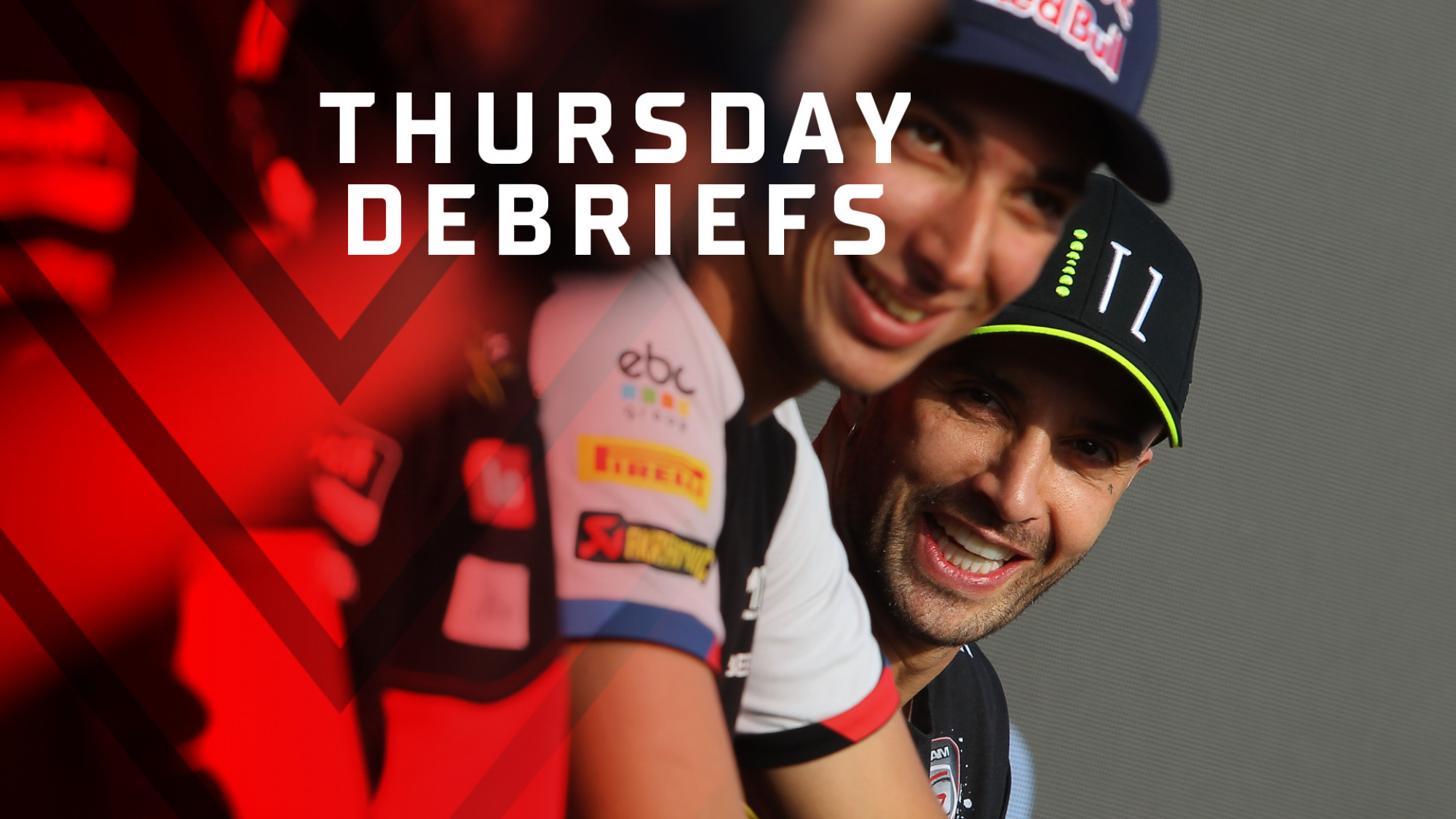
Chapter three of the 2024 MOTUL FIM Superbike World Championship season is about to take place at the legendary TT Circuit Assen in the Netherlands. Countless classics at this track and also in recent rounds mean that 2024’s Pirelli Dutch Round is destined to be one for the ages; we caught up with the main stars on Thursday during WorldSBK’s media day.
Toprak Razgatlioglu (ROKiT BMW Motorrad WorldSBK Team): “I have a dream this year to win the Championship”
Two wins last time out at a track he and BMW had never won at, Assen has also been a place where Toprak Razgatlioglu and BMW haven’t mounted the top step: “I’ve never won here at Assen in the Superbike class; I hope I can this weekend. It looks a little strange as the weather can always change easily. It’s cold but I’m ready to race in both wet and dry races. I have a dream this year to win this Championship; I can’t say before the end of the season. My dream looks possible. I am happy with Michael as a teammate and the atmosphere in the garage is very good and we work well together. If BMW ask me, it’s easy to say Michael, he’s a good teammate, a good guy and respectful; we work together in the race and Superpole. Maybe at this track, he’ll help me as he knows it better than me –in the wet, he’ll show me the best line!”
Alvaro Bautista (Aruba.it Racing – Ducati): “I’m not in a hurry to make a decision”
With silly season in full flow, Alvaro Bautista’s future could hold the key to many for 2025: “To win a race is always very important, but especially after coming from a difficult winter for me with my injury and also the feeling I started with the bike in testing that was not the best. It was very important to recover the good feeling during the Barcelona weekend. I think the win was the consequence of this feeling and from my physical condition. It gave me a lot of confidence for the rest of the Championship. Honestly, I don’t have anything on my mind about my future. It’s been very tough for me. In Barcelona, I recovered the good feeling. I always say I keep racing because I’m having a lot of fun riding my bike and with a good feeling. It’s important to have a good feeling on my bike and try to always improve. With this crazy grid, you have to be an even better rider than before! I try to always be a better rider. I’m just focused on this and trying to be better and better. I’m not in a hurry to make a decision.”
Nicolo Bulega (Aruba.it Racing – Ducati): “This could be the most difficult race for me”
Back after arm-pump surgery, Nicolo Bulega says this could be his most difficult round yet: “I had some problems during the races so I decided to have the surgery before Assen as this track is a bit difficult physically, with the change of direction. With the Superbike, it can be hard. I decided to do it before this race and I’m still not at 100% but I am recovering day by day and I can ride well. I always push at 100% when I’m on the bike; this could be the most difficult race for me because we’ve had the test before the other races. I also come here after the surgery, without a test, so perhaps Friday will be more difficult for me. I’m happy because it’s a track I like a lot and I’ll try to do my best.”
Michael van der Mark (ROKiT BMW Motorrad WorldSBK Team): “We want to be on the podium!”
After a strong Barcelona, the rostrum is the aim for home-hero Michael van der Mark: “It’s always nice to arrive at your home track when you’ve had some decent results before. In Australia and especially Barcelona, we had some really good results. We come here with confidence and knowing the base we have is really good. We want to be on the podium, and we’ve had a good start to the season. We have a good base and we’re fast. It would be nice to be on the podium. It’s a nice confirmation knowing you have a bike that can fight for the podium and victories. It takes a little bit of pressure away. We know the package is there, we just have to finetune it and focus on riding. Honestly, the only thing I can do is deliver results. I’ve been unlucky the last two years. I’m fit, I’m feeling good on the bike and all I can do now is deliver results.”
Jonathan Rea (Pata Prometeon Yamaha): “We have to walk before we can run”
17 wins and 25 podiums: will Assen’s most successful rider, Jonathan Rea, get his season off to a proper start after six races where he’s struggled: “I’m really excited to be back at Assen, I like the layout of the track and also my fans bring some good energy here. It’s just a case of trying to find some form and performance both from myself and the R1. I think Catalunya Race 2 was my first normal race with no issue, so I banked some points. What I realised was starting from P13 is that it’s so difficult to reach that front group, so it was a race I started making progress. It’s not the positions we want to fight for, but we have to start somewhere after a lot of disappointments. Looking forward to seeing if Assen can bring us some more fortune. Looking back at previous years, it’s a track that suits not just me but the Yamaha R1. It’s a place we can make that step, but it’s a step by progress. We have to walk before we can run.”
Andrea Iannone (Team GoEleven): “My target is to be in a factory team… I felt interest from many manufacturers”
Back at Assen and looking to his future, Andrea Iannone made a bold claim for 2025: “I’m a little bit excited because it’s really good to be back here. I won in the past in my first year in Moto2™ and also, I’ve had really good races more or less every year at this track. It’s the first race we don’t have a test before the round and I’m a little bit worried because I don’t know what happens, but I hope we immediately start in a good way. I don’t know about my future. I’m happy I’m being spoken about, but I don’t know at the moment. I want to continue to live this moment and I’m focused on riding well because I know if I’m on top, I have many chances. My target is to be in a factory team, but we will see. After a long time, I felt many things and I felt interest from many manufacturers. I’m honoured. I think after Assen, in Misano, we will know something more about this.”
Alex Lowes (Kawasaki Racing Team WorldSBK): “Anything can happen when the weather’s a little bit inconsistent”
In the top three of the Championship, Alex Lowes is keen to show Kawasaki’s potential at Assen: “Conditions are always a little bit mixed here at Assen. I know the bike and track well, so I think if there’s minimal dry time, it could be good for us. We have to adapt well to the situation. Anything can happen when the weather’s a little bit inconsistent. We have to make sure we make the right decisions, put ourselves in a good position and I think, dry or wet conditions, we can be quite optimistic about the weekend. This weekend, if we can fight for the podium, be in the mix with the front guys fighting at the front, I think we can be happy and that’s the target. I don’t really know about the future, it’s very early. We’ve got a big break after the Assen round with so long until the next round, so maybe there’ll be some more news in the break. From my side, I don’t know yet. I started the year really strong with Kawasaki, I’ve changed some of the working environment inside the team so it would be nice to keep this progression.”
Andrea Locatelli (Pata Prometeon Yamaha): “Let’s push and see what we can do”
With a first win still to be had, can happy memories from previous Assen outings spur Andrea Locatelli on: “I have good memories form Assen; I got my first WorldSBK podium here in 2021 and I’ve had a podium every season with Yamaha here, so why not try to repeat it this year? It won’t be easy and probably this weekend, we’ll ride in different conditions with the forecast will be tricky. I feel comfortable though and OK with the bike, so let’s push and see what we can do. We have a really good feeling and it’s a flowing track, so it’s another good track to show our potential and speed. We’ll push for the maximum and see what we have. Toprak was a big surprise for everyone as we didn’t think it could happen immediately but they’re working well during testing and they found a good solution for the race. I’m happy for him because, firstly, he’s my friend and I have a good relationship with him. He’s a big talent; I sent a message to him because I missed him after the race. I want to try and fight again this weekend.”
Watch Assen from wherever you are and whenever you want with the WorldSBK VideoPass!
Source: WorldSBK.com
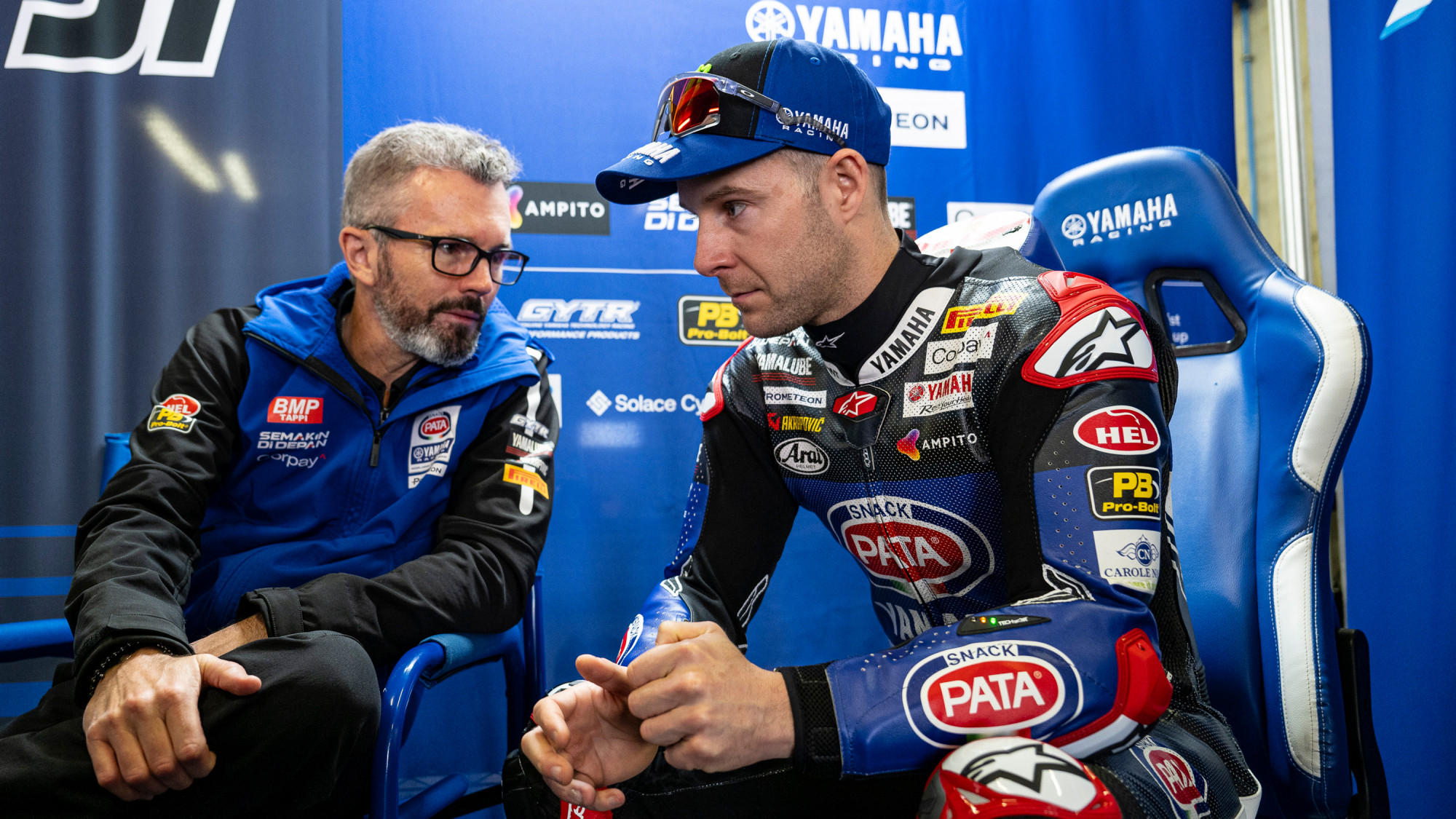
One of the big moves for the 2024 MOTUL FIM Superbike World Championship season was Jonathan Rea’s bombshell transfer to the Pata Prometeon Yamaha squad after nine seasons racing for Kawasaki. The #65, however, didn’t take former Crew Chief Pere Riba with him to Yamaha, with Rea working with former teammate Andrew Pitt moving across the box to be his new Crew Chief. Ahead of the Pirelli Dutch Round, Rea spoke about the challenges of adapting to a new team without Riba by his side and how there is a period of adjustment when switching teams.
Rea first joined Kawasaki for the 2015 season, winning six titles between then and 2020 before a few difficult seasons in 2021, 2022 and 2023. Following those challenging campaigns, the Ulsterman opted to move to Yamaha with a seat available following Toprak Razgatlioglu’s (ROKiT BMW Motorrad WorldSBK Team) move to BMW. Speaking at the TT Circuit Assen, Rea expanded on one of the challenges of moving teams and manufacturers other than having to adapt to a new machine.
“It’s hard to answer,” he began when speaking in his media debrief. “Just getting familiar with a completely new crew, understanding how they work and them understanding how I work. It’s step by step. I really believe in everyone inside Yamaha. They’re great people, intelligent people. I had a relationship with my previous crew chief that spanned nine years. There were growing pains in that relationship as well. There were times it wasn’t great but generally, for example, if you said ‘left’, with that kind of relationship, they telepathically knew how far left.
“With a completely new crew that’s worked with different riders, it’s very hard for them to understand me without words. In the previous rounds, I spent a long time in the pit box trying to explain my feelings clearly. That’s also new for me, and that can also be a big problem; a rider talking too much as you can create more and more problems from a technical point of view. It’s just step by step. I think that situation couple with a few issues we’ve faced, and difficulties, the challenges of Phillip Island and crashes, it’s been tough to put everything together, but I do feel like it’s going to come.
One key aspect will be how crew chiefs work, with everyone having their own style to achieve the best possible result. At Kawasaki, Rea exclusively worked with Riba as his Crew Chief, leading to unprecedented success with more than 100 wins for the Japanese manufacturer and six titles. Following his move to Yamaha, the 37-year-old now has Pitt as his Crew Chief. The pair raced together but now have a different relationship as they look for success.
Expanding on the differences between the two, where Rea made sure to praise both, the #65 said: “They’re more similar than you can imagine, to be honest. Both are very clever. I was going to say Andrew’s worth ethic is incredible and he’s so busy and ruthlessly competitive, always trying to find something, and he’s pushing all the crew to do their best. Andrew’s pushing the electronics department, the chassis department, to improve, but Pere was the same.
“The biggest difference is I worked with Pere for nine seasons and sometimes I didn’t have to speak. When you look at the rider market, for example, Toprak went the other way but took his crew chief, but they then have to learn another bike. Would it have been an advantage to have Pere by my side now? Not sure. Maybe from communication and understanding me, but he doesn’t understand the R1. There’s pros and cons to everything. The relationship with Andrew is really good. I trust him and trust in Yamaha that it’s going to come good. Been a difficult start, to be honest. We have to have some faith. Keep my head up and hopefully we can get back to some normality here.”
THE NEW ERA CONTINUES: can Rea get back to winning ways at Assen? Find out using the WorldSBK VideoPass!
Source: WorldSBK.com
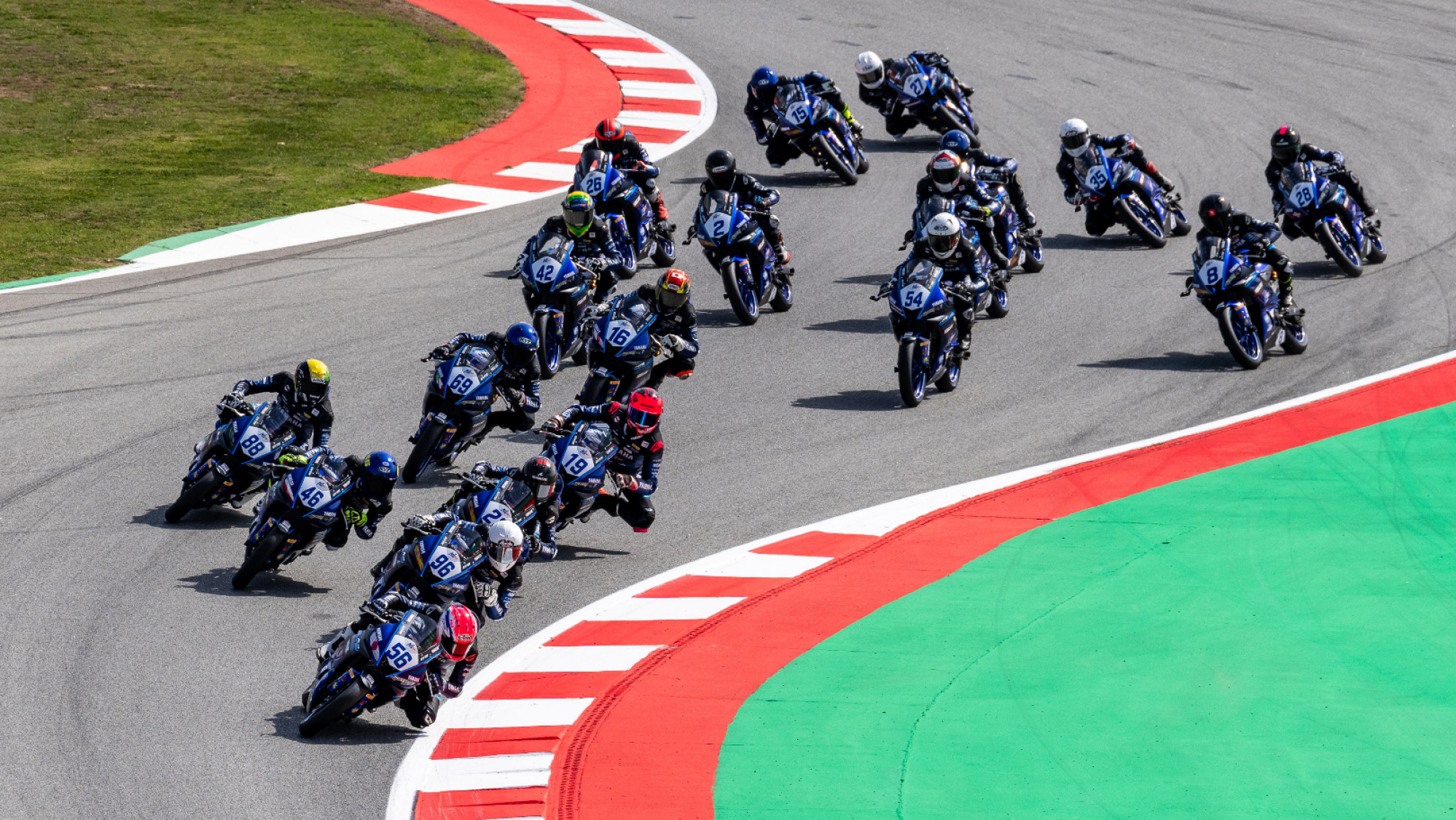
The second round of the freshly renamed FIM Yamaha R3 bLU cRU World Cup will take place this weekend, April 19-21st, at the classic TT Circuit Assen in the Netherlands, and the MOTUL FIM Superbike World Championship’s youngest competitors are eager to get back on track after a record-breaking Round 1 last month.
The opening event of the season in Barcelona saw Spanish rookie and 2023 R3 SuperFinale winner Gonzalo Sanchez take victory in dominant style in Race 1, setting a record for the biggest winning margin in class history at 11.101 seconds. The 15-year-old repeated the feat in Race 2, this time gapping his rivals by 8.744 seconds. Behind the speedy Spaniard the battle for the remaining places was hotly contested with plenty of overtakes and great skill demonstrated by the field of 19 riders. Poland’s Dawid Nowak and Czechia’s Nikolas Zanin achieved their first R3 podiums over the Barcelona weekend, while class stalwarts Spain’s Marc Vich and Brazil’s Eduardo Burr proved they mean business again this year by returning to the rostrum.
Barcelona also played host to the first ever live stream of the R3 World Cup races, something which will continue this weekend in Assen and throughout the 2024 season to allow audiences all over the world to follow the progress of the future Superbike stars.
Assen will be the home race for Dutch rider Indi Schunselaar, the youngster rider in the series at just 14 years old. Barcelona was a steep learning curve for the rookie, but he will be aiming high in front of his Yamaha Benelux supporters at a track he knows well.
Race 1 and Race 2 will take place on Saturday April 20th and Sunday April 21st at 11:50 CET. Last year the incredible layout of the TT Circuit provided all-out action among the sport’s hungry youngsters so be sure to follow along LIVE via Yamaha Racing’s YouTube channel and stay up to date on yamaha-racing.com
Source: WorldSBK.com
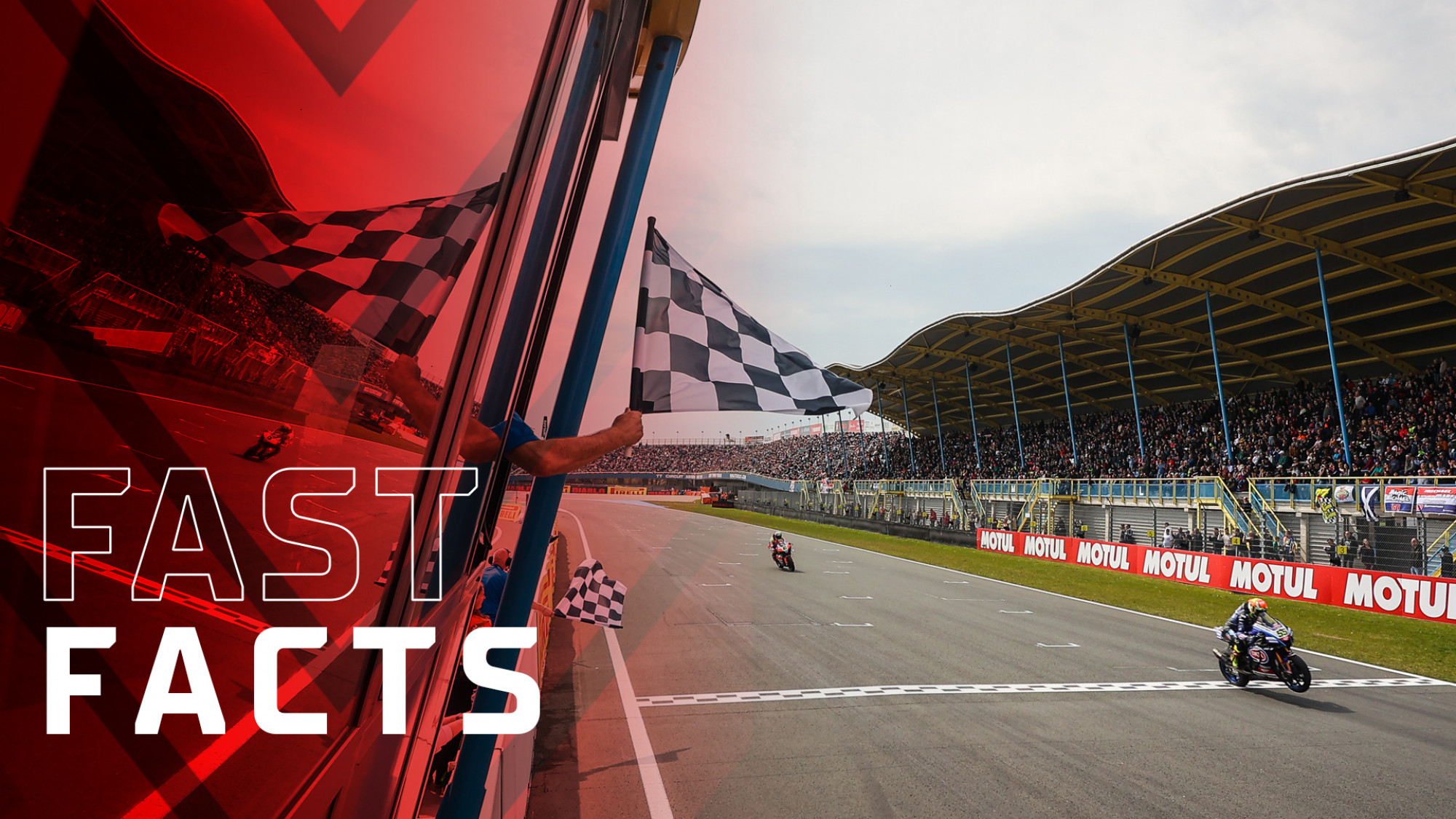
Through the cloud and cold, the TT Circuit Assen welcomes the 2024 MOTUL FIM Superbike World Championship for the third round of the season. The legendary Dutch venue has been a round of excitement, drama and passion throughout WorldSBK’s history and records often fall on this hallowed turf. Impress those around you with some World Superbike knowledge below.
2023 race winners:
Last three pole-sitters at Assen:
Manufacturer podium places (and wins) accumulated from all races at Assen:
Key gaps from Assen 2023:
Manufacturer top speeds at Assen, 2023:
Watch Assen from wherever you are and whenever you want with the WorldSBK VideoPass!
Source: WorldSBK.com
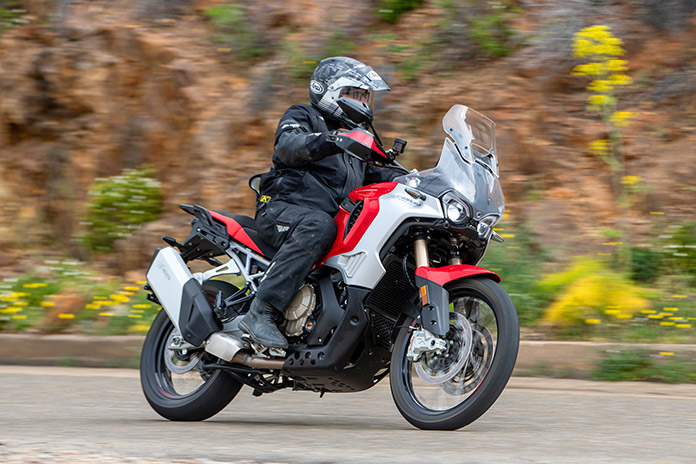
If you asked what I thought about MV Agusta around 2010, I’d quickly respond: Beautiful Italian lines and attitudes but priced for the very few.
Then, in 2012, MV introduced the F3 sportbike, offering the inline-Triple platform in relatively affordable 675 and 800 versions. The 675 performed decently for its short time in World Supersport from 2013-2020, taking five 3rd-place finishes and one runner-up.
The Triples ignited the Varese company’s new focus and opened the door to a broader range of riders – although still only for those with larger bank accounts. The F3s were followed by other models over the years, including the Dragster naked, Turismo Veloce sport-tourer, Superveloce neo-classic sportbike, the Rush hyper naked, and updated Brutale nakeds, among other special editions.
Related: MV Agusta Dragster RR SCS America Review | First Ride
At EICMA 2023, MV unveiled its first-ever adventure tourer – the LXP Orioli. The previous “Lucky Explorer” moniker, an homage to the Cagiva Elefant’s Paris-Dakar campaigns, was retired in favor of a tribute to Italian rally legend Edi Orioli.
Related: MV Agusta Lucky Explorer Project | First Look Review
This signified a transformation within the Italian brand to enter the adventure-touring market, something that made sense given its new relationship that began with Pierer Mobility – the parent company of KTM, Gas Gas, and Husqvarna – which had acquired 25.1% of the brand. This helped MV expand its lineup and launch a new product line in the brand’s historic factory in Schiranna.
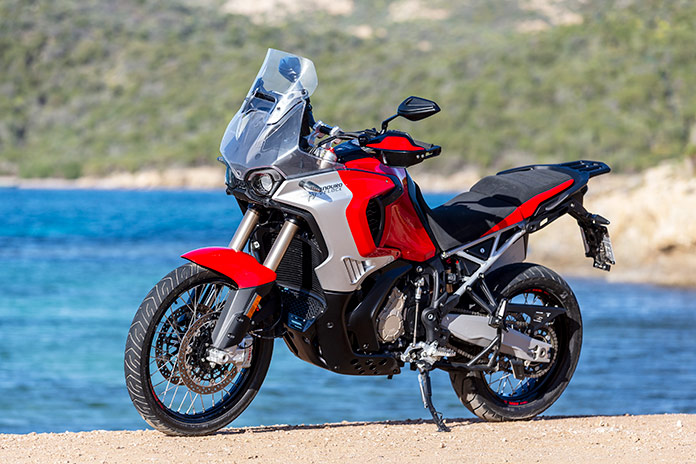
The business news continued to grow for MV Agusta, and in March of this year, Pierer Mobility increased its stake to 50.1%, gaining majority control of the brand.
The LXP Orioli is a beautiful machine, but only 500 will be made and each one costs a princely $29,000. This exclusivity changed with the release of the new Enduro Veloce, basically a base version of the LXP Orioli, which joins the MV lineup as the brand’s first full-production motorcycle in the fast-growing adventure touring segment.
The MV Agusta Enduro Veloce continues to celebrate the company’s racing history, specifically honoring the triumphs of the 1940s-era MV Agusta 98. The 98 was famously piloted by Vincenzo Nencioni to win the Golfo di La Spezia off-road race in 1946, followed by another notable win by Carlo Ubbiali at the British Six Days race in 1949.
To test the Enduro Veloce, I traveled to Sardinia, a Mediterranean island that’s a semi-autonomous region of Italy, where I logged 150 miles on mostly paved roads with a brief off-road excursion. Although the launch was mostly street-focused, with Bridgestone A41 (80/20) tubeless tires on its 21/18-inch spoked wheels, the small amount of dirt riding on bikes wrapped with the knobbier AX41 (50/50) tires proved the Enduro Veloce can hang with the latest adventure tourers.
I’d classify the Enduro Veloce as an 80/20 adventure tourer and a direct competitor to the Ducati Multistrada V2, Triumph Tiger 900, and BMW F 900 GS. But it’s much prettier, mostly due to MV Agusta’s focus on the “horizontal versus vertical” design philosophy, which translates to all bodylines, engine structures, graphics, paint, and every element flowing naturally from front to back and vice versa.
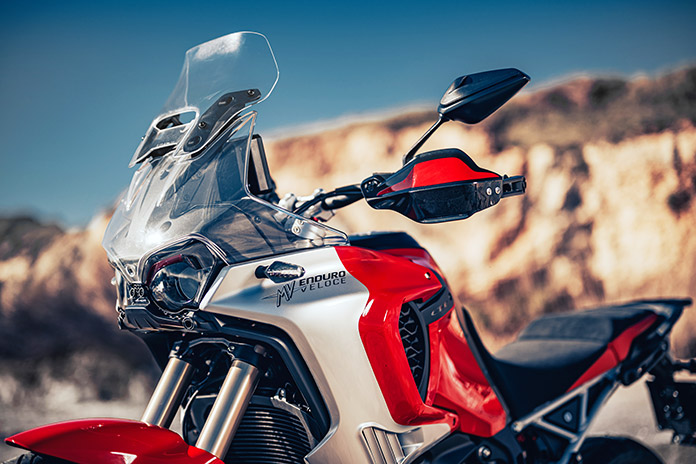
And would you really want to drop this fine-looking piece of Italian motorcycle art that costs nearly $23,000? If it meant exploring some of the world’s best two-track backcountry, I’d say hell yeah, especially because the road sections getting to those gravel roads will be so much fun.
Read all of Rider‘s MV Agusta reviews here.
At the heart of the Enduro Veloce lies a 931cc powerplant that is the brand’s most radical departure from its predecessors. Unlike the 798cc Triples in other models, the Enduro Veloce’s engine is a clean-sheet design by the Varese R&D team, emphasizing lightness, compactness, and efficiency.
Weighing in at just 125.6 lb, the engine is 10% lighter than other MV Triples, yet it packs a formidable punch with claimed 124 hp at 10,000 rpm and 75.2 lb-ft of torque at 7,000 rpm. The engine’s lightness helps keep the bike’s purported dry weight to 494 lb, though the bike is likely to weigh more than 530 lb when the 5.3-gallon fuel tank is full and oil and coolant are added.
Yes, the Enduro Veloce is considerably heavier than the wet weights of around 480 lb for the KTM 890 Adventure and 490 lb for the Ducati Multistrada V2. At a photo stop, I nearly dropped the bike when my foot slid on some rocks, and it took muscle and a fellow rider (thanks, Costa!) to help arrest my fall. But while riding the MV, it felt nimble and light, even during 1st-gear speeds while turning around on tighter roads.
The real MV magic, however, begins as soon as the electronic throttle is opened. Approximately 85% of maximum torque is accessible from as low as 3,000 rpm, and it remains linear and potent up to the 7,500-rpm mark, where it gently starts to taper off. But for those looking for that extra oomph, this bike quickly revs to the “soft” 10,200 or “hard” 10,500 rev limit, keeping the exhaust note high and the riding exciting.
During the first few miles, the broad spread of torque allowed me to short-shift and ride lazily, letting the grunty engine do all the work. But the Enduro Veloce has a Dr. Jekyll and Mr. Hyde quality, and soon I began revving the bike nearly to the hard limiter before shifting, awakening the bike’s hooligan side.
One of the most notable features of the Enduro Veloce is its counter-rotating crankshaft. This feature, typically reserved for high-performance racing machines, counteracts the gyroscopic effect of the wheels, enhancing the bike’s agility and responsiveness.
During acceleration, the design notably balances the load on the 21-inch front wheel, which helps retain stability and control, especially when navigating the endless tight switchbacks and uneven asphalt in Sardinia. Despite the large-diameter front wheel, the bike remained remarkably nimble and willing to obey the slightest inputs.
The Enduro Veloce’s auditory experience is as refined as its mechanical performance. I’m a guitar player and love how a musician like Stevie Ray Vaughan can go from clean tones to screaming, deep mid-tones within seconds. The Enduro Veloce’s engine replicates this with a flick of the wrist.
The stock muffler is a big exhaust can, but it produces a symphony that crescendos near the rev limit, turning heads and signaling the raw power within. This exhaust note not only enhanced the riding pleasure but deepened my connection to the machine. The sound was most impressive above 10,000 rpm, creating an explosive pop while shifting. This process was facilitated by the smooth-operating 6-speed transmission, featuring a flawless up/down quickshifter.
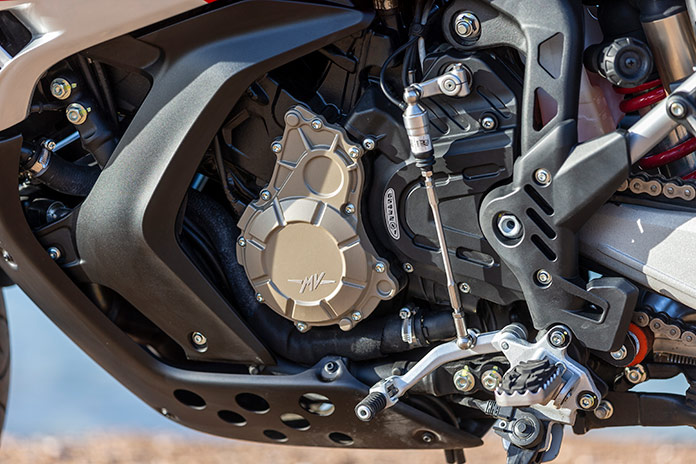
The Enduro Veloce delivers commendable fuel efficiency for its class, averaging around 40 mpg under mixed riding conditions. This efficiency translates to a range of more than 200 miles from its 5.3-gallon fuel tank if not riding like a loon, allowing for extensive journeys between refuels.
All this performance is managed by a sophisticated electronics suite. Wisely, the developers kept everything simple and intuitive to access through the controls and large 7-inch TFT display, providing simple-to-read data with beautiful graphics.
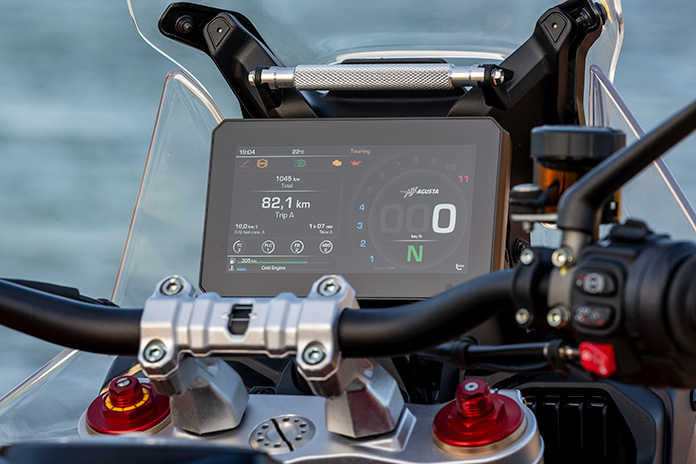
It all begins with riding modes, with inputs calculated from the 6-axis IMU: Urban, Touring, Off-Road, and Custom All-Terrain. The typical Sport mode is noticeably missing, but since everything can be tweaked, I simply made the Custom mode my version of Sport by altering the parameters to my liking. In each riding mode, you can adjust throttle response, engine torque, and engine response (how quickly it revs). There are also two levels of engine braking separate from the riding modes, allowing riders to tailor how the bike slows down when easing off the throttle.
The Enduro Veloce features eight levels of traction control: five for road use, two for off-road, and one for wet. The TC settings be switched on the fly, including deactivation in any mode, and they can be fine-tuned depending on whether you’re rolling on the stock Bridgestone A41 80/20 tires for mainly street riding or the optional AX41 50/50 tires for heavier off-road use.
The Enduro Veloce is also equipped with cornering ABS and rear-wheel lift mitigation (RLM). The ABS system is only switchable and customizable in the Off-Road and Custom modes, and both ABS and RLM can be changed while riding. Level 1 (lower intervention on the front wheel; off on the rear; cornering off; less invasive RLM) was optimal for off-road, allowing me to skid the rear and rely on some front ABS for harder braking. Level 2 offers full intervention. For the Custom mode that I was using as my personal Sport mode, I also used Level 1 ABS and totally shut it off a few times for added fun.
Three other rider aids are cruise control, wheelie control, and launch control. The cruise control performed flawlessly, relieving my throttle hand during longer highway stretches. Launch control seems more appropriate for a sportbike or a hyper naked, but hooligans will be hooligans, and I had fun with it at a few stop signs and on an isolated section of a straight road. Just push the “LC” button, pull in the clutch while in 1st, open the throttle, and when it tells you, release the clutch. This should help achieve the claimed 3.7-second acceleration from 0 to 60 mph, and the soundtrack is pure SBK.
The Enduro Veloce is built around a perimeter frame with a double-cradle design, complemented with a double-sided aluminum swingarm. This construction shifts from the gorgeous single-sided swingarms seen on all other MV models in its current lineup, emphasizing functionality over aesthetics.
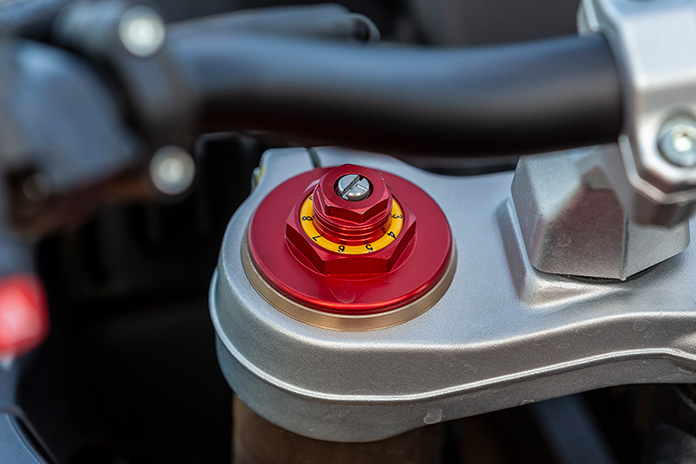
Given its price, the absence of electronic suspension on the Enduro Veloce is notable. Yet the fully adjustable Sachs suspension – with a 48mm inverted fork at the front and a rear shock featuring progressive linkage – proved highly capable. I weigh around 185 lb, and the only tweak I made throughout the test was half a turn on the shock’s preload knob. Nothing else was needed.
The suspension and wheel setup combined with the engine character impressed me all day. At first glance of the bike, with its 8.3 inches of suspension travel, 9 inches of ground clearance, and off-road ready wheels, I expected poor cornering stability. But I was wrong. The chassis remained stable throughout the corners, barely diving or squatting, allowing me to hold my line without much input. Thanks to the cornering ABS, I also experimented with some harsh, mid-corner brake jabs in an attempt to upset the chassis. The bike recovered quickly, allowing me to return to my line and finish the turns safely.
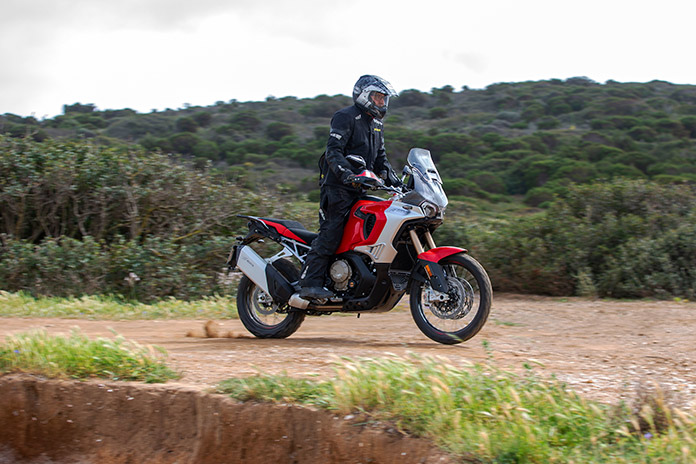
When I tested the bike with AX41 rubber for the off-road section, the long-travel suspension provided a plush feel. I didn’t adjust the suspension due to the short time I spent riding the dirt-ready Enduro Veloce, but the suspension in its stock settings felt ideal for lighter off-road use, allowing the bike to rebound quickly.
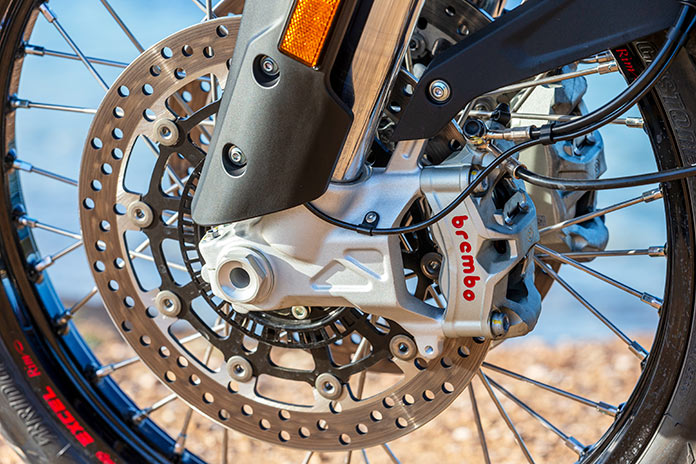
The Enduro Veloce is equipped with top-shelf Brembo Stylema radial monoblock front calipers, which clamp onto 320mm discs. The front lever feel is distinctly Brembo – accurate and responsive. This becomes evident when applying trail-braking techniques. The front lever provides substantial feedback and only a slightly bumpy feel when testing the true capabilities of the cornering ABS.
Thanks to the design of its dual-height seat (33.5/34.3 inches), I was able to comfortably flatfoot at stops, which enhanced control and confidence, especially in slow traffic. While the seat provided reasonable comfort for most of the day, it became uncomfortable toward the end of the ride.
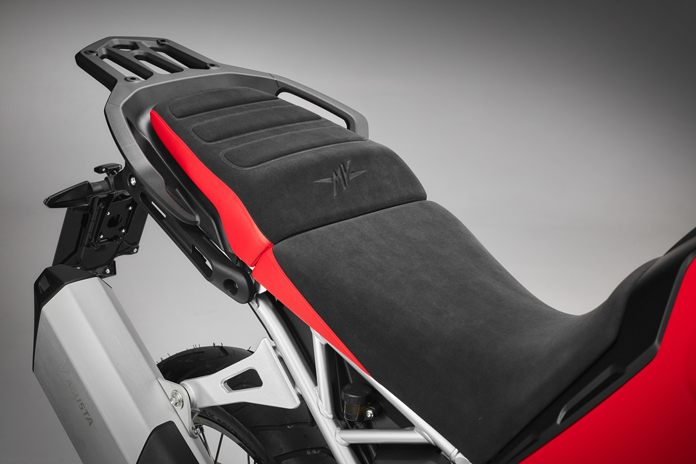
The handlebar, which initially appeared high, offered all-day comfort for my 6-foot frame. The MX-style bar is also adjustable to accommodate more aggressive off-road stances, which is helpful for either taller riders or those standing up for most of the day.
The footpegs are well-positioned for my 34-inch inseam and height, contributing to an ideal rider triangle and relaxed riding posture. The pegs also arrive with rubber inserts that dampen vibrations at highway speeds, enhancing comfort over long distances. These inserts can be quickly removed to switch to grippier cleated pegs for better control while off-roading.
And although I wore a peaked Arai XD-4 helmet, I didn’t experience major head buffeting – just some minor shakes at the top of 6th gear. The fairing and two-piece windscreen that’s split in the middle (but is not adjustable) optimize the airflow around the body.
In keeping with MV Agusta’s motto of creating “motorcycle art,” the Enduro Veloce has distinctive LED headlights. LEDs are also used for the turnsignals, taillight, and backlighting for the handlebar controls, a feature that would be handy during night rides.
Other convenience features include a keyless ignition system and the ability to connect mobile devices to the bike through the MV Agusta My Ride App, enabling navigation, communication functions, and sharing and tracking of ride data.
Remember the days of riding European motorcycles and worrying about frequent valve checks? MV Agusta fixed that issue, and the Enduro Veloce’s maintenance scheduling is streamlined. You won’t have to worry about valve checks until 18,600 miles. MV recommends oil changes every 4,600 miles and spark plug and air filter replacements every 9,300 miles.
The MV Agusta Enduro Veloce marks a bold entry into the adventure-touring market, blending MV’s rich racing pedigree with modern technological ADV advancements. Its form follows function, delivering both style and performance on twisty mountain roads and rugged trails.
From the 931cc Triple’s thrilling power delivery to the sophisticated electronics suite and agile chassis, this motorcycle is designed to enhance the riding experience. The counter-rotating crankshaft and carefully tuned suspension system ensure the bike remains nimble and responsive, irrespective of the terrain, and its comfort and features make it a versatile machine. It is a great choice for riders who want a blend of style, performance, and exclusivity – the hallmarks of MV Agusta’s legacy.
Check out more new bikes in Rider’s 2024 Motorcycle Buyers Guide
The post 2024 MV Agusta Enduro Veloce Review | First Ride appeared first on Rider Magazine.
Source: RiderMagazine.com
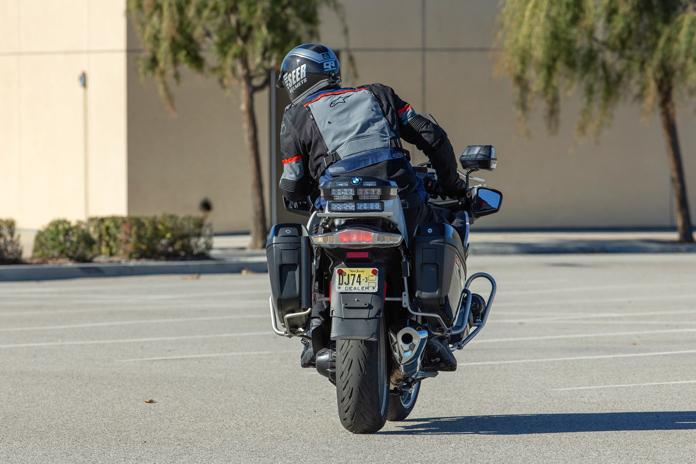
Hey, a smidge of Dr. Seuss-inspired thinking never hurt anybody. Moreover, while this article is dropping in May, I’m writing it during the holiday season, and I’m full steam ahead on a speed-train of hot cider and gingerbread treats, so loosen up. Now, where was I about the feet thing? The sugar coma is real.
Oh yes, your feet. Let’s kick it off with a question: When you ride your streetbike, do you ever give much thought to your feet? I don’t mean if they are cold, if they are comfortable, or if you think they look small when people, um, size you up. No, I mean do you use them to gain better control and comfort in slow-speed riding situations? Anyone?
No worries, have a gingerbread cookie and I’ll walk us through some footwork concepts while we initiate maximum carb-load protocol.
Now, if I’m known for one thing in police motorcycle competitions, it’s my extreme lean angles when I counterbalance. A close second is my ability to rapidly transition the motorcycle from one direction to the other. And while there are several techniques at play to make those things happen, a major contributing factor is how I use my feet.
No, I don’t expect you to sign up for any police motor competitions, but developing your footwork will provide you with a higher level of ability and control in street situations.
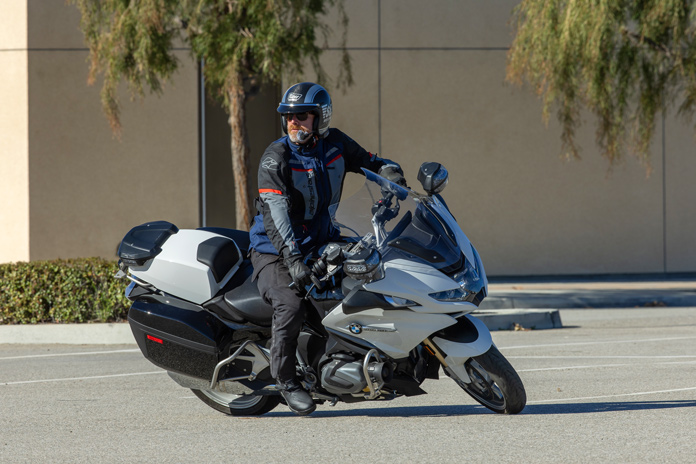
As discussed in last month’s column (“Which Way Do You Lean?”), when executing slow-speed turns, we benefit from counterbalancing, which “counters” the motorcycle’s weight as it leans over by simultaneously shifting our weight in the opposite direction of the motorcycle. But there are two fundamental challenges riders have with this technique: 1) they don’t counterbalance nearly enough, causing the motorcycle to fall in faster than they wanted yet not as far as would allow for a tight turning radius, and 2) they struggle getting the motorcycle out of the lean once they accomplish the turn they initiated. Not great. But dammit, these cookies sure are, right?
Here’s where my feet come in to save the day. When it’s time to initiate a tight turn and lean my motorcycle over, I use my inside foot to push down on the peg. This not only helps push the motorcycle over, but simultaneously generates a stable platform from which I can push myself into a greater counterbalance position. Imagine we are turning a tight right-hand U-turn. We start to lean the motorcycle over, and the inside peg, along with the seat and bars, are all falling over, causing us to feel as if we are going down with the ship. In other words, everything we are connected to is falling over all at once. But if we use our inside foot to press against the peg as it falls over, we generate force that stabilizes us in the counterbalance position and more easily leans the bike over.
One final benefit to employing our feet is for the exact opposite reason I’ve mentioned already, namely to pick up the bike once we complete the turn. How? By adding force to the outside peg at the right moment. Three more cookies and I’ll land the plane, I promise.
Weighting the outside peg is useful in two important ways. First, by generating force in the opposite direction of the lean via shifting pressure onto the outside peg, I’m helping the motorcycle stand back up. And second, I’m taking my bodyweight away from the overall mass that needs to be picked back up, which further helps get my heavy bike upright and moving in a new direction.
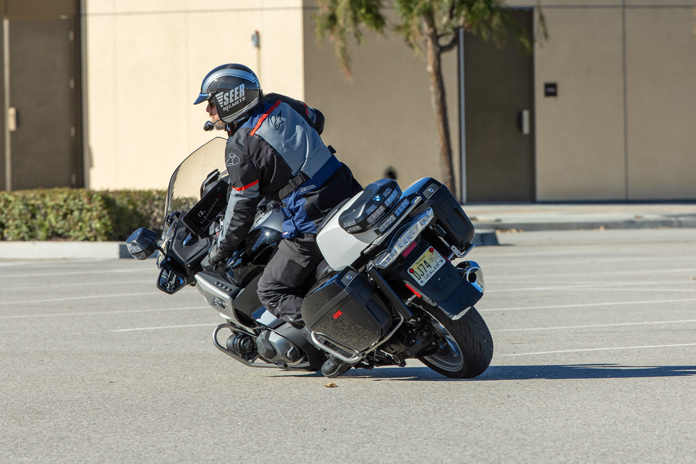
Here’s what this looks like. Say I’m dropped over in a slow, tight U-turn and I am now turned around and want to pull out of the lean. At that moment, I keep my body counterbalanced but concentrate my mass so that when I add pressure to the outside peg, I help lift the bike back up yet avoid “pushing” my bodyweight to the inside of the bike. Think of this technique in the same way as getting out of a car: You step one leg out, but before you add pressure, you ensure your weight is over the foot so you don’t simply fall back inside the car when you add force, then you press yourself up and out.
With your motorcycle leaned over, you place your weight over the outside peg and then press, causing both your leg force and lack of body mass to work together to upright the bike. And just like the car example, if you press without getting your weight over the peg first, you will push your body in the direction the motorcycle is already leaned over (causing you to “fall back into the car”), which will only make it harder to stand the bike back up. Do you need another cookie, or are we clear up to this point?
To get a feel for this, we’ll work some figure-8s to practice both the drop-in and pick-up components of the technique. With your bike in 1st gear, start riding a moderate-sized figure-8 pattern. You don’t need to slip the clutch here, just execute the pattern while staying smooth and relaxed. What you are looking for is awareness of what your feet are doing (or not doing) as you turn within the pattern. Let’s focus on your inside foot first, adding pressure on the peg to gain stability, help the bike lean over, and increase counterbalance range of motion.
Once you can employ the inside foot efficiently and confidently, isolate the outside foot. Concentrate on a stable, balanced push on the peg, making sure that the push doesn’t shift your weight toward the direction of the lean. Remember, you are helping the bike pick itself up here, so shifting your weight to the inside with a bad push only hinders this goal. Once you master it, put it all together.
This technique works just fine whether you have footpegs or footboards. Yes, footboards are farther forward, and you will need to rework your foot placement, but where there’s a will there’s a way. To see this lesson in action, go to Police Motor Training with Quinn Redeker on YouTube and look for “Foot Technique For Better Riding.”
Find Quinn at Police Motor Training.
See all Motor School with Quinn Redeker articles here.
The post Motor School with Quinn Redeker: Left Foot, Right Foot, Heavy Foot, Light Foot appeared first on Rider Magazine.
Source: RiderMagazine.com
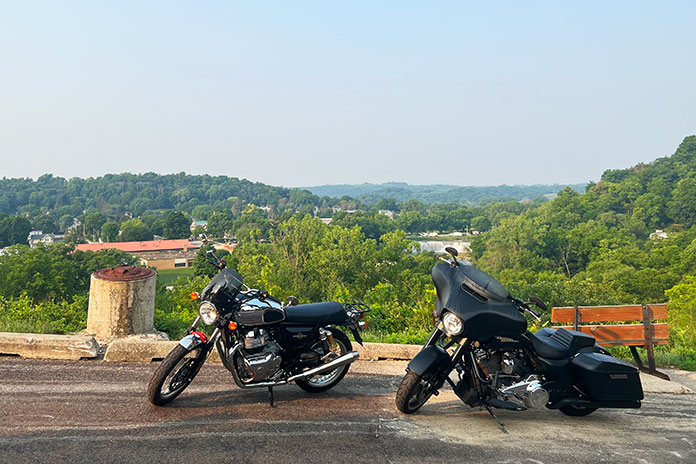
Motorcyclists living in Minnesota experience long winters with plenty of time to think about roads we want to ride. It’s a sweet feeling when spring arrives and the bikes come out of hibernation.
My son, Chad, feels the same way. We kicked off the riding season with an overnight Minnesota motorcycle ride down the Great River Road (U.S. Route 61) on the western bank of the Mississippi River, through what is often referred to as Bluff Country. The area’s complex hilly terrain has been carved out over eons by the Mississippi and other waterways large and small.
Scan QR code above or click here to view the route on REVER
Minnesota’s Great River Road is a popular motorcycle route that offers epic beauty and a chance to visit towns along one of America’s most vital corridors of commerce. Starting in April with the annual “Flood Run” charity ride, thousands of riders thunder up and down these roads and frequent the many small-town bars and restaurants along the way. I’ve been on many of these roads before, and I love riding old favorites and exploring new side routes.
Related: Exploring the Far North: A Northern Minnesota Motorcycle Ride
We left the Twin Cities early on a Saturday morning to beat traffic, and our first stop on this Minnesota motorcycle ride was the town of Hastings, which serves as a gateway to Bluff Country. The Hastings Riverwalk is a relatively new paved trail that connects to a 10-mile walking and biking loop along the Mississippi and Vermillion rivers. You can’t miss the towering Hastings Bridge, various sculptures along the waterfront, and the original footings of the Spiral Bridge, which was built in 1895 and dismantled in 1951.
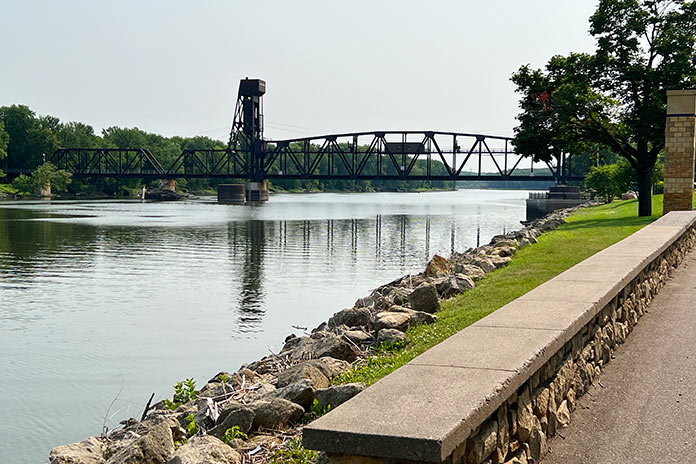
East of Hastings, we continued south on the Ravenna Trail, one of the great lesser-traveled roads that tracks closely to the Mississippi River. We took the trail to the Prairie Island Indian Reservation and Treasure Island Casino, which boasts a 788-room hotel and Vegas-style casino attracting top entertainers. Resisting the temptation for easy money, we pushed on to rejoin U.S. 61.
Our next stop was Red Wing, a town established in the 1850s to support steamboats moving up the Mississippi River toward vast available farmland. By 1873, Red Wing was a leading wheat producer, but it was eventually surpassed by Minneapolis where larger flour mills were built. Today the town is perhaps best known as the home of legendary boot maker Red Wing Shoes. The downtown St. James Hotel was founded in 1875 and has hosted U.S. presidents, Mark Twain, and other luminaries. Downhill from the hotel is the historic train station, which has old wooden benches and period signage on the walls. I could sit there all day watching the river roll by.
Continuing south, we visited Lake City, which sits on a wide stretch of the Mississippi called Lake Pepin, the birthplace of waterskiing. The lake was once a water highway used by Native Americans, and there are burial mounds and settlement ruins located nearby. Today, you’ll see raw materials being moved in barges and recreationists enjoying themselves in sailboats and ski boats.
Towering above both sides of Lake Pepin are distinctive limestone bluffs and tree-covered rock formations. With such unique scenery, it’s a challenge to keep your eyes on the road ahead. One minute you are feeling the heat from the tarmac and gazing up at high bluffs, and the next you’re ripping through dense maple forests enjoying the cool air and earthy smells. For golf lovers, the Lake Pepin Golf Course has 12 holes laid out atop the bluffs overlooking the Mississippi River Valley.
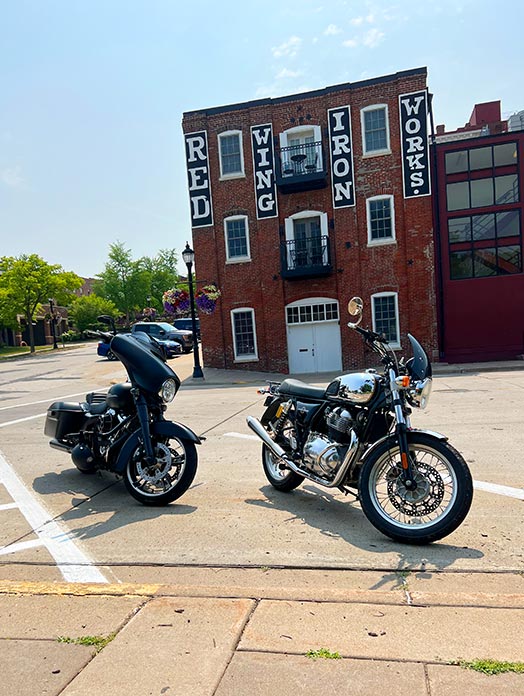
We arrived at the next small town on our route, Reads Landing, just in time for lunch. This was once considered as a potential capital city for Minnesota due to its booming lumber trade and strategic location on the Mississippi and Chippewa rivers. Reads Landing Brewing Company occupies an old red-brick building with an outdoor patio overlooking the river. It has a full menu and was a great place to cool off and relax.
Adding to the Great River Road’s natural beauty is an abundance of birds soaring overhead. The National Eagle Center in Wabasha houses permanently injured bald eagles and provides an opportunity for people to see these majestic creatures up close.
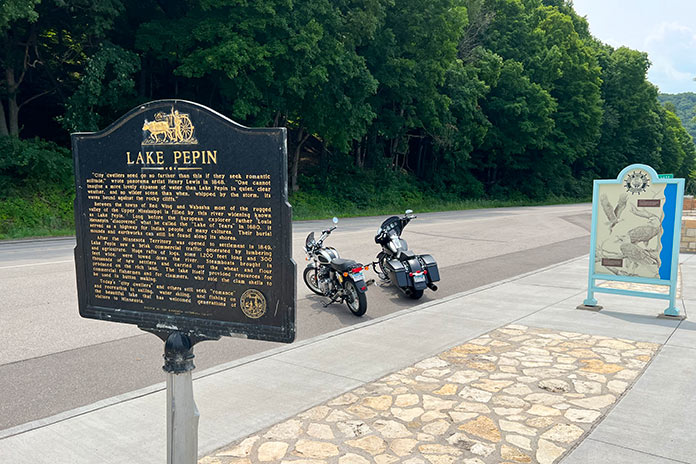
As we continued south, we approached Winona, a vibrant college town that’s home to the Minnesota Marine Art Museum, which is located right on the river and exhibits artwork inspired by water. With a variety of dining and lodging options, recreational opportunities, live music, festivals, and shopping, Winona is a great destination for an overnight stay or weekend getaway.
Southeast of Winona, on County Road 7, is Pickwick Mill, one of the oldest flour mills in Minnesota, built in the mid-1850s. The mill was named by the area’s first postmaster, who was a fan of Charles Dickens and his novel The Pickwick Papers. During the Civil War, it produced 100 barrels of flour per day for the Union army.
See all of Rider‘s Minnesota motorcycle rides here.
After returning to U.S. 61 and riding along the Mississippi to La Crescent, we turned west on the Historic Bluff Country National Scenic Byway (State Route 16). Even away from the river, bluff topography continues with hills and cliffs creating the winding roads we all live for. Through the towns of Hokah, Houston, and Rushford, we paralleled the Root River and the Root River State Trail, a rails-to-trails bike path linking the towns of Houston and Fountain.
After nearly 50 miles on the byway, we arrived in Lanesboro, an art, entertainment, and recreational hub where we spent the night. We stayed at the historic Hotel Lanesboro, which was built in 1872 from local limestone and is on the National Registry of Historic Places. Formerly a boarding house called Mrs. B’s, it once hosted Buffalo Bill and Doc Powell. The hotel is right on the main street with many good restaurants nearby. We had a tasty dinner at the Pedal Pushers Cafe, a nod to the many bicyclists who ride the state trail.
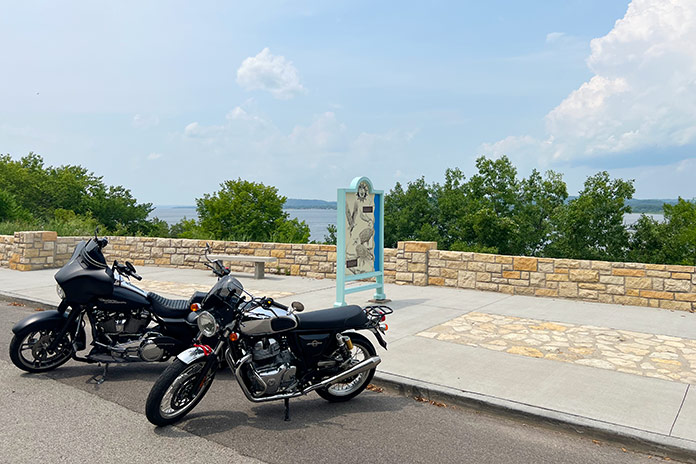
My Harley is much louder than Chad’s Royal Enfield, and I felt guilty breaking the morning silence as we headed to the towns of Preston and Harmony. This area is Amish country, and it wasn’t long before we saw our first horse and buggy. Friendly and always good for a wave, the Amish are an interesting subculture. There are about 1,000 Amish in Harmony, and you can take tours to learn more about their way of life and visit shops with baked goods, furniture, and more.
Seeing a horse with buggy tied up at a local convenience store, I pulled a quick turn to stop and take a picture. Soon two young ladies with bonnets saw me as I attempted to pocket my phone, not wanting to look like a gawking tourist. They wished me a good morning as they untied their horse and climbed aboard to clip-clop down the road.
See all of Rider‘s Midwest U.S. touring stories here.
Harmony is also home to Niagara Cave, where you can take a tour 200 feet below the surface. It’s well worth it for this mile-long underground hike to see the various rock formations and even a subterranean wedding chapel.
We continued south on U.S. Route 52 to Prosper, a stone’s throw from Iowa, where we headed east and then north on State Route 44 to Caledonia, picking up State Route 76, which has twisties so enjoyable that we rode some sections twice. SR-76 took us north most of the way back to Winona, where we backtracked north on U.S. 61 to Wabasha. We then turned west on State Route 60 and joined a pack of bikers thundering in the same direction. Alongside the road is a lone sentinel, a skeleton biker that’s a reminder to keep the rubber side down.
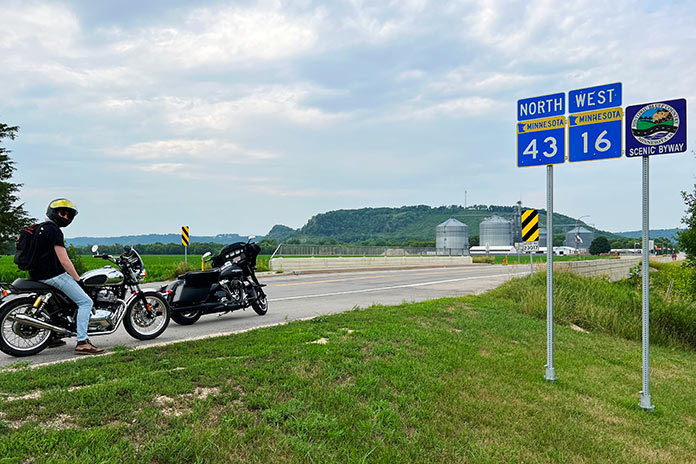
As we left the river and Bluff Country behind, the terrain flattened out as we made our way to Zumbrota, home of Minnesota’s last remaining functional covered bridge. Spanning the Zumbro River, the 116-feet-long, 15-feet-wide bridge was built in 1869 and looks like a long, red barn.
We rode northwest to Northfield, where in 1876, Jesse James and the James-Younger gang rode into town to rob the First National Bank. Facing pistols, the bank clerk refused to open the safe and was shot to death. Townsfolk retaliated, resulting in a shootout that killed another resident and a couple of gang members. The gang was pursued for 400 miles over the following weeks, eventually being captured in Madelia, Minnesota. Jesse James escaped, but his luck ran out when he was killed in 1882 by one of his own men hoping to collect a $10,000 reward.
We rode west to Henderson, which sits along the Minnesota River Valley National Scenic Byway, another favorite road. Henderson is an old river town with a historic downtown district that’s a fun place to visit.
Our Minnesota motorcycle ride through Bluff Country and along the Great River Road and other scenic byways gave us a taste of the history, beauty, and variety of southern Minnesota. The roads showcase some of the best riding, relaxing, and motorcycle-friendly places the state has to offer.
See all of Rider‘s touring stories here.
The post Beauty in Bluff Country: A Southern Minnesota Motorcycle Ride appeared first on Rider Magazine.
Source: RiderMagazine.com
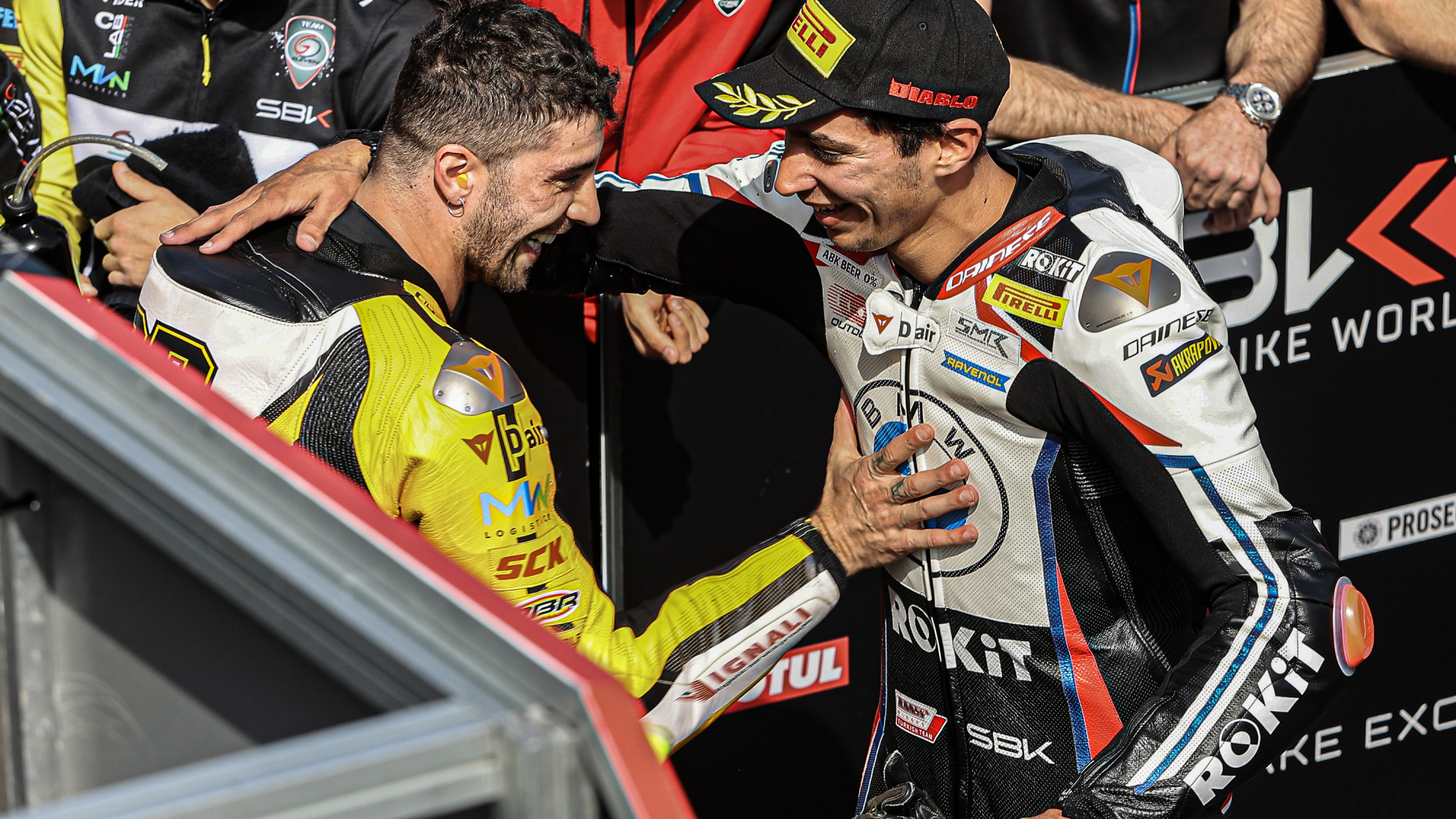
Two rounds into the 2024 WorldSBK season and Toprak Razgatlioglu (ROKiT BMW Motorrad WorldSBK Team) has stolen all the headlines. Never mind that we have a rookie leading the Championship, Andrea Iannone (Team GoEleven) back on podium pace after four years on the side-lines or a six-time World Champion struggling to find his feet with a new bike. Toprak is the headline maker and the attention grabber. It was expected that we’d see Razgatlioglu winning races aboard the BMW M 1000 RR. It was a surprise to see him win in Catalunya in just his fourth race for his new team. The resources being ploughed into the BMW project from Munich meant that the tide would turn in their favour but doing in Montmelo was a surprise even to the team.
BMW BRILLIANCE: Toprak’s ability and van der Mark’s return to the fore
It was a pleasant surprise for Marc Bongers, BMW Motorrad Motorsport Director, who was caught in Parc Ferme saying “I’ve never been so happy to spend money!” when it was mentioned that there was a lot of bonus money to be paid out in Barcelona! It won’t be the only bonuses that Toprak receives this year. The form of Razgatlioglu has impressed everyone but surprised nobody. He’s the best pound-for-pound rider in WorldSBK at the moment and his racing instinct came to the fore for both wins. Managing the tyres in Race 1 to take the lead with half a lap to go or pouncing on Alvaro Bautista (Aruba.it Racing – Ducati) at the last corner to win the Tissot Superpole Race showed his razor-sharp mind. To see teammate Michael van der Mark so competitive too will give a lot of reason for hope at BMW.
It’s one thing for your lead rider to perform like Razgatlioglu but it’s quite another to see van der Mark back on the pace. Qualifying on the second row and being in the lead group throughout Sunday’s races was impressive. Finishing fourth in Race 2 has given the Dutchman a big lift ahead of his home round. Assen is always special and he can sprinkle something into the air this weekend too. He’s had a torrid two years with three serious injuries but when he was fully fit last year, he was the BMW rider to beat. He knows that to keep his seat alongside Razgatlioglu, he has to make sure that his Catalan performances are the norm rather than the exception. This is a rider that has finished third in the World Championship in the past and won races on Yamaha and BMW machinery along with a pole position and podiums on the Honda. The 2014 WorldSSP Champion is still competitive and wants to ensure he stays within BMW.
SILLY SEASON STARTS SOON: round four in 2023, perhaps earlier in 2024?
Last year, there were rumours about which rider BMW would keep. Would it be van der Mark or Scott Redding. Through two rounds, there’s little doubt within the paddock that the right decision was made. To see Razgatlioglu and van der Mark working together during the Superpole session proved the right decision had been made. Team harmony is critical to success in racing and it’s hard to see how a Redding and Razgatlioglu pairing would have been anything beyond civil.
At his best Redding is one of the most talented riders in the world and a race winner on any given day but if he is to stay in the World Championship he needs to outperform van der Mark and Garrett Gerloff. Consistency will be key for that but if he struggles to match their speed it’s difficult to see where Redding lands on the WorldSBK grid.
LOOKING TO 2025: “BMW is now an attractive prospect for a host of riders on the grid”
Adding to the challenge is that BMW is now an attractive prospect for a host of riders on the grid. Toprak showed you can win on the bike and he’s sure to challenge for wins this weekend. There are plenty of Independent riders waiting for factory contracts. Suddenly, the BMW one is as attractive as any. The rider market spins slower in WorldSBK than MotoGP™ but with GP seats starting to fill the momentum will shift to the WorldSBK paddock. Who will be available from MotoGP™? What seats could they fill? The next two rounds could be critical for van der Mark and Redding. Assen is the self-proclaimed ‘Cathedral of Speed’ so don’t be surprised to see some riders praying for good results.
EVERY SECOND LIVE: watch all the action from 2024’s new era with the WorldSBK VideoPass!
Source: WorldSBK.com
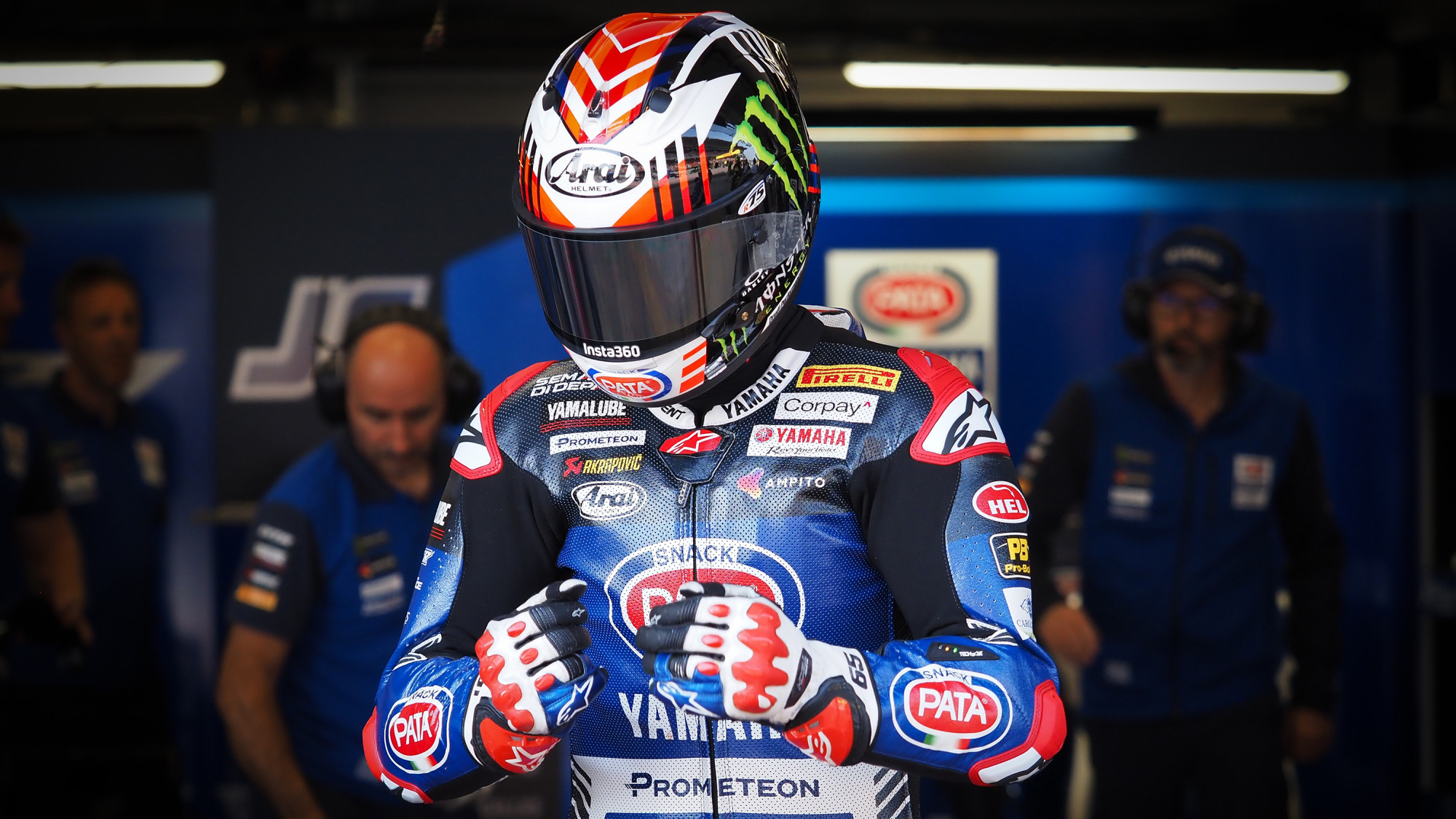
The 2024 MOTUL FIM Superbike World Championship is nearing the completion of its first quarter as the TT Circuit Assen awaits and the Pirelli Dutch Round. The Cathedral of Speed has often led to being the home of dreams and this year, the Pata Prometeon Yamaha team of Jonathan Rea and Andrea Locatelli will be hoping to be fast from the start. It’s been a tricky start to 2024 for Rea, with just eight points from six races whereas teammate Locatelli has been on the podium and fighting for race wins, even if Barcelona was a round where he struggled more. You can enjoy a full in-depth chat with Paul Denning here, before getting the team boss’ thoughts ahead of round three below.
Assen is a circuit where Yamaha have been competitive at in the past but not won at in 15 years; Ben Spies was the last winner there in 2009’s epic Race 1, whereas Noriyuki Haga gave Yamaha their first and only other win in 2000’s hair-raising Race 2. Recent years have seen Toprak Razgatlioglu on the podium, as well as Andrea Locatelli – who has taken a rostrum there in the last three years, including his first in 2021. However, this year is different and with Jonathan Rea aiming to breakthrough onto the rostrum, where better to do it than at the track where he’s won 17 times and been on the podium at 25 times.
“WE DON’T EXPECT TO GO FROM ZERO TO HERO” – can Rea mount a rostrum charge?
Looking ahead to Assen, Denning previewed the Pata Prometeon Yamaha hopes: “As a neutral, the start of the Championship has just been awesome. I fully expect more very exciting racing and great action. From our perspective, particularly on JR’s side, we need to roll out in FP1 with a package that immediately gives him confidence and build the weekend from there. He’s won 17 races at Assen, it’s ridiculous! It’s a track that he’s always given his best level at and there have been seasons where perhaps it’s been more of a struggle with the Kawasaki but he’s still been on for a competitive result there. It’s a great place; we don’t expect to go from zero to hero but it’s a great track for him to take a significant step and build the rest of the season from. On Locatelli’s side, he’s riding full of confidence, chipping away very intelligently at the programme and I don’t see why he can’t be ultra-competitive at Assen.”
A LOCATELLI WIN AT ASSEN? “It’s a good opportunity for ‘Loka’ to make that next step”
Talking more about Locatelli’s start to the season, Denning was impressed with the #55 despite misfortune: “There are still frustrations on Loka’s side in that the unfortunate last lap problem at Phillip Island where – in the very worst case – he’d have finished third if he’d have given up on the job but it looked like he was going to finish second or first, cost us a chunk of points. Then, avoiding an accident on the first lap in Barcelona meant that he could only come back and grab a couple points at the end of the race. If you take off his first lap time, his pace was more than good enough for a finish in the top four so he should be P2 or at worst P3 in the standings. It’d be a nice confirmation of the potential but it’s clearly there and he’s riding better than ever.”
Summarising overall, will Assen be the place where ‘Loka’ mounts the top step? “We’re in a position right now as a team, rider and manufacturer where you can’t get away with any compromises or mistakes; everything has to be on point to have a chance at challenging for victory. If we can get everything on point at Assen, then I think it’s a good opportunity for ‘Loka’ to make that next step.”
Watch Assen from wherever you are and whenever you want with the WorldSBK VideoPass!
Source: WorldSBK.com